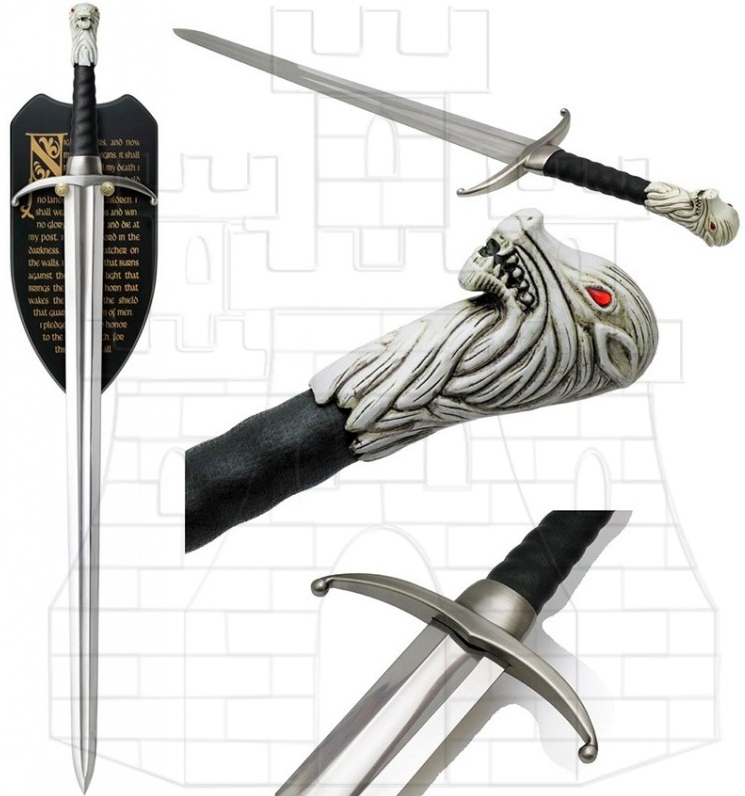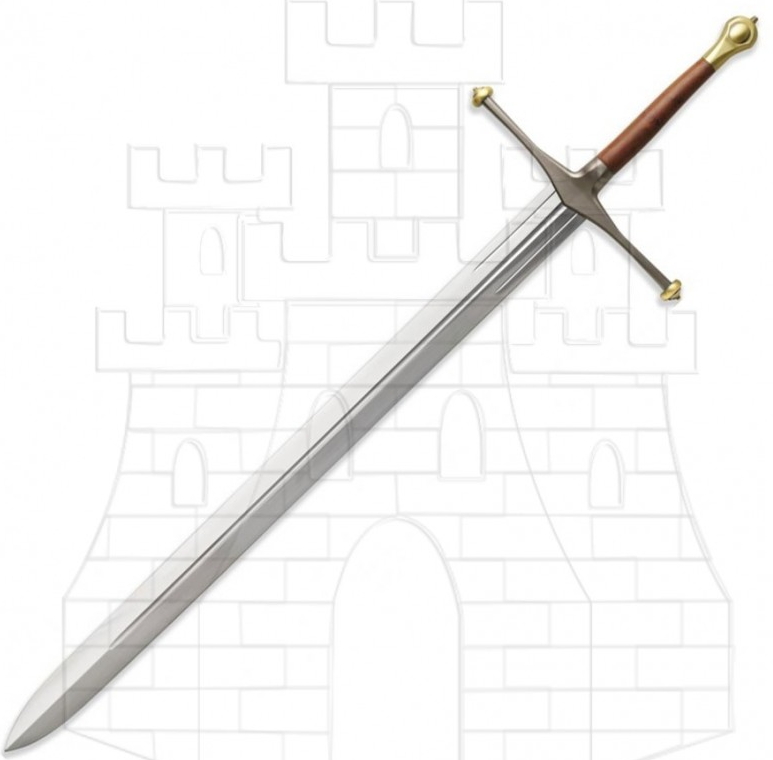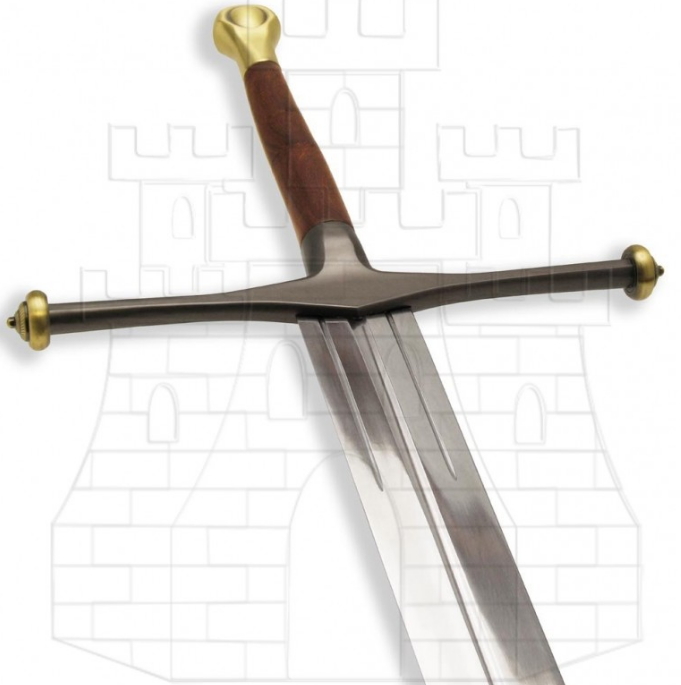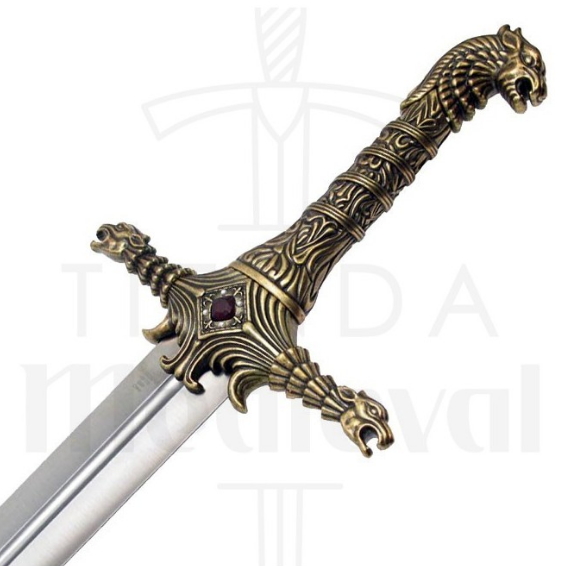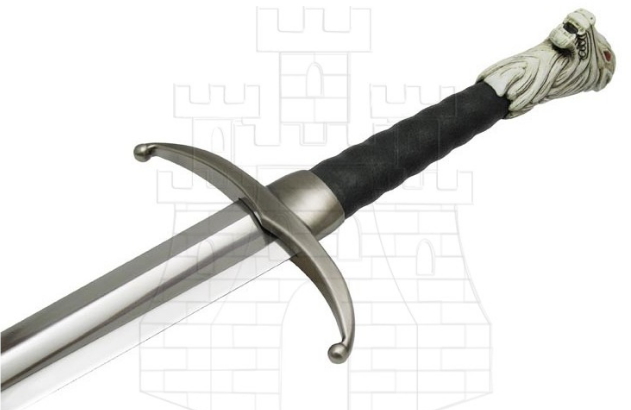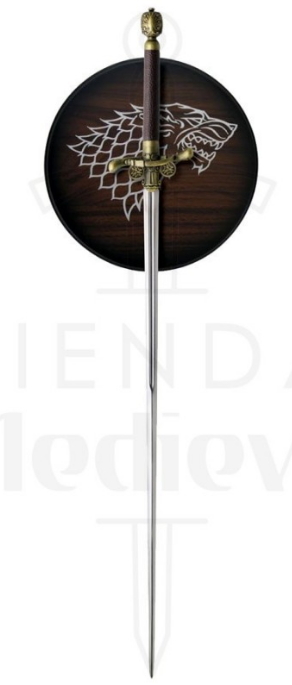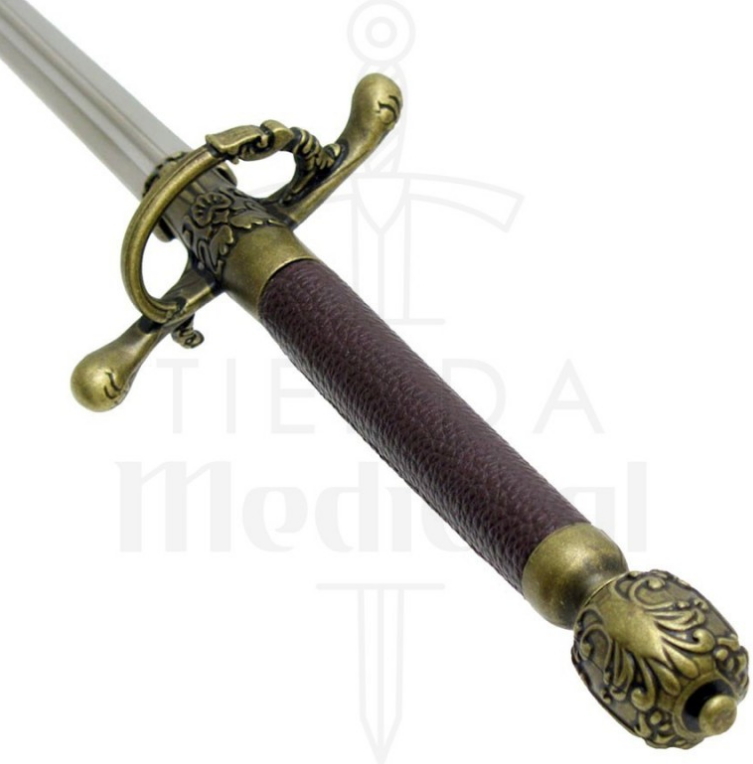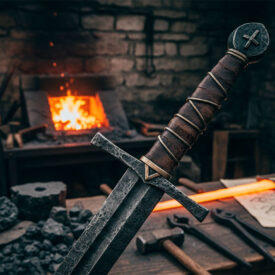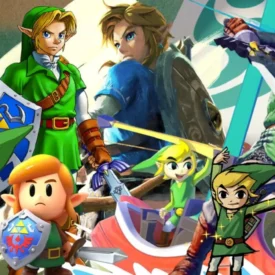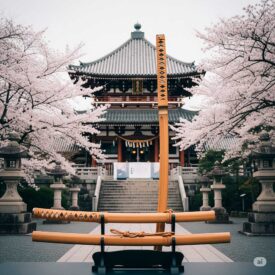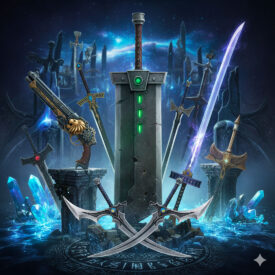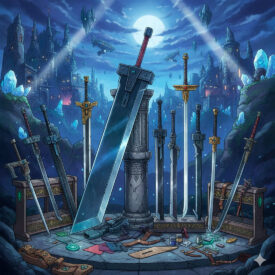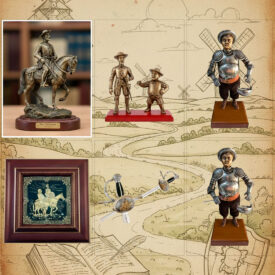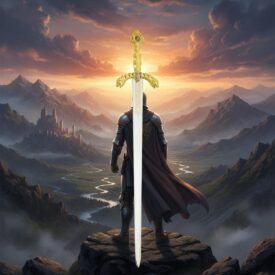Game of Thrones is a fantasy novel saga written by George R. R. Martin, consisting of seven novels. It is also the first installment of the hugely popular A Song of Ice and Fire series, which averages 13.6 million viewers, reflecting the outstanding plot quality and its captivating power over the audience.
The series is set in a fantastic Medieval world, in constant war among its peoples, a setting where magic and the mythical creatures of the past have not been forgotten. Game of Thrones gives us a great opportunity to enjoy various fantasy swords that are much more than mere combat instruments. They are emblems of power, guardians of ancestral legacies, and silent witnesses to epic tales. Each blade forged in this fantasy universe embodies the ideals, ambitions, and often the tragic fate of its wielders. Join us as we discover the secrets of some of the most famous swords in “Game of Thrones”, exploring their history, deep symbolism, and how they reflect the essence of their bearers.
The Profound Importance of Swords in Westeros
On a continent ravaged by wars and conspiracies, a sword can be the boundary between life and death. However, its value transcends its function: they are family heirlooms passed down from generation to generation, symbols of the authority of entire houses and often key elements that drive the plot. The most revered are, without a doubt, those forged from the legendary Valyrian steel, a material with almost mystical properties whose creation is an almost forgotten art.
It is fascinating to observe how many of these swords have names with great meaning, closely tied to their owners’ fates. Whether inherited, stolen, or given as gifts, each change of owner marks a crucial turning point in the narrative of Game of Thrones. These weapons not only cut and defend, but also weave the complex web of alliances, betrayals, and loyalties that define the world of Westeros.
Valyrian Steel: Between Myth and Master Forging
Valyrian steel is undoubtedly the most coveted and mysterious material for sword-making in Westeros. Its creation is an ancestral secret lost with the Fall of Valyria, the ancient advanced civilization. The forging process is said to involve dragon fire and blood magic, giving it exceptional lightness, unparalleled sharpness, and almost indestructible strength. This quality makes it the most desirable material for any warrior or noble house seeking a decisive edge on the battlefield.
Blades of Valyrian steel are distinguished by their characteristic wavy pattern, similar to Damascus steel, and usually showcase dark tones with reddish or bluish highlights that make them unmistakable. The ability to reforge this material is extremely rare, mastered by very few smiths in Essos, such as Tobho Mott in King’s Landing, who played a key role in transforming one of the most iconic swords of the series, Ice, into two new and significant blades. The rarity and mystery surrounding Valyrian steel only increase its value and the prestige of owning one of these legendary Game of Thrones swords.
Emblematic Swords and Their Stories
Throughout “Game of Thrones,” several swords have etched their names into fans’ memories, not only for their design but also for the stories that surround them and the weight they bear. Each of these swords is another character in the plot, with its own story and a significant impact on the fate of Westeros.
Ice: The Imposing Sword of House Stark
Ice was the gigantic two-handed sword of House Stark, a colossal blade forged from Valyrian steel that was the family’s relic for centuries. Nearly two meters long and with the characteristic dark gray of Valyrian steel, it symbolized honor, justice, and the indomitable strength of the North. Ned Stark mainly used it for executions, reflecting the Stark philosophy that he who passes the sentence should wield the sword. Its imposing presence in the series made it one of the most recognizable swords in Game of Thrones.
The fate of Ice reflects the tragedy of House Stark. Following Ned’s execution, the sword was stripped of its essence, melted down and transformed into two new blades by Tywin Lannister’s order: Widow’s Wail and Oathkeeper. This act symbolized the disintegration of the Stark family and the Lannisters’ attempt to annihilate their power, marking a brutal turning point in the Game of Thrones narrative. The melting of Ice was a shocking moment for fans, representing the destruction of an ancestral legacy.
Widow’s Wail: The Sword of the Cruel Young King
Widow’s Wail was one of the two swords created from Ice, given to Joffrey Baratheon by Tywin Lannister as a wedding gift. Joffrey, in an act of cruelty, gave it that sinister name as a macabre reminder of Ned Stark’s execution. Although the king showed his sadism by testing its edge on a book and by threatening Sansa and Robb with it, the last time he wielded it was to cut his wedding cake, before succumbing to poison. The hilt of Widow’s Wail, somewhat shorter than its counterpart, is adorned with a golden lion head with ruby eyes, a clear nod to the Lannister emblem. This sword, though briefly in Joffrey’s hands, became a symbol of his tyranny and cruelty.
Oathkeeper: Loyalty Forged in Steel
The other sword forged from Ice was Oathkeeper. Tywin Lannister originally gave it to Jaime, who then gave it to Brienne of Tarth. The name “Oathkeeper” was chosen by Brienne in honor of her unwavering dedication to the promise Jaime made to Catelyn Stark regarding her children. This sword became an emblem of Brienne’s unyielding loyalty and honor, key elements of her character in Game of Thrones.
Oathkeeper, with its distinctive red and black waves on the blade, became in Brienne’s hands a symbol of honor, loyalty, and the fulfillment of duty—values House Stark has always treasured. This sword played a crucial role in protecting Sansa Stark and defending the North, indirectly serving the Stark cause despite originating from the destruction of their own ancestral sword. The story of Oathkeeper is a testament to how swords in Game of Thrones can transcend their origin and acquire new meaning through their bearers.
Longclaw: The White Wolf’s Companion
Longclaw, a Valyrian steel bastard sword, is House Mormont’s ancestral heirloom. Although its rightful heir, Jorah Mormont, dishonored it by fleeing Westeros, his father, Jeor Mormont, Lord Commander of the Night’s Watch, deemed his son unworthy and presented it to Jon Snow. As a symbolic gesture of Jon’s new connection to House Stark, Mormont replaced the original pommel, a bear’s head, with that of a white wolf. This sword is not only a formidable weapon but also a symbol of Jon’s destiny in Game of Thrones.
In Jon’s hands, Longclaw became a vital instrument in the fight against the White Walkers, proving that Valyrian steel was lethal to these icy creatures. This sword accompanied Jon through countless battles and trials, symbolizing his evolution from bastard to leader and his acceptance of his complex identity as the Stark family’s “white wolf.” The importance of Longclaw in the series underscores the transcendence of swords in Game of Thrones not just as weapons, but as narrative elements that define the characters.
Needle: The Rebellious Spirit of Arya Stark
Needle is the slender sword Jon Snow gave to his sister Arya before leaving for the Night’s Watch, forged by Mikken, Winterfell’s blacksmith. Its name, “Needle,” was a nod to Arya’s lack of interest in traditional feminine activities like sewing and symbolized her desire to forge her own path. This small and agile sword, designed as a thin rapier, was perfect for Arya’s petite stature and her quick, precise fighting style, inspired by the “Water Dance” she learned in King’s Landing. Needle’s uniqueness makes it one of the most beloved swords in Game of Thrones.
Needle was more than a weapon for Arya; it became an extension of her identity, a bond to her family and her Winterfell past, even when she was trying to become “no one” in Braavos. It symbolizes her rebelliousness, determination, and her journey toward self-discovery. This Needle sword belonging to Arya has the official series license and each sword is individually serialized. It includes a beautiful wall mount and certificate of authenticity. Arya’s emotional connection to Needle is a clear example of how the swords in Game of Thrones carry deep personal meaning.
Other Notable Swords and Their Meaning
In addition to the most prominent Valyrian steel swords, the Game of Thrones universe is full of other blades with unique stories and significance, further enriching the lore:
- Valyrian Steel Dagger: This mysterious Valyrian dagger is perhaps the most significant weapon in the saga. It first appears in a failed assassination attempt on Bran Stark, triggering a series of crucial events. Later, Arya uses it to execute Petyr Baelish and ultimately to deliver the final blow to the Night King, ending the Long Night. Its role at key moments makes it one of the most important swords in Game of Thrones, despite its small size.
- Lion’s Tooth & Hearteater: Joffrey Baratheon’s swords, known for their grand names but limited in actual combat use. They reflect their bearer’s pompousness and lack of true bravery.
- Heartsbane: House Tarly’s Valyrian steel relic. Samwell Tarly steals it from his father, and Jorah Mormont uses it in the Battle of Winterfell, proving its lethality against White Walkers.
- Dawn: The only great sword in existence forged from a meteorite, with a unique “milk glass” hue, wielded by Ser Arthur Dayne, the Sword of the Morning. Its mystical origin distinguishes it from Valyrian steel swords.
- Dondarrion’s Flaming Sword: A sword engulfed in flames used by Beric Dondarrion, possibly referencing Azor Ahai’s mythical Lightbringer. Its magical nature makes it unique among Game of Thrones swords.
Dragonglass: The Other Lethal Foe of the White Walkers
Along with Valyrian steel, dragonglass, or volcanic glass, is another crucial material in the fight against White Walkers. With its deep black color and sharp edges, dragonglass causes these icy creatures to disintegrate on contact. Found in great deposits like Dragonstone, this material was used by the Children of the Forest millennia ago, and is crafted into arrowheads, daggers, and spear tips through careful breaking and polishing. The importance of dragonglass in survival strategy against the threat from the North is as vital as that of Valyrian steel swords, providing an accessible alternative to arm Westeros’ defenders.
The Art of Forging in Westeros and Essos
The skill of blacksmiths is fundamental in Westeros for weapon quality. From legendary Valyrian steel blades to the sturdy swords of the Night’s Watch, the art of forging is essential. Master smiths like Tobho Mott guard ancestral secrets of metallurgy, passing on knowledge vital for making swords capable of withstanding the fiercest battles in Game of Thrones.
Forging techniques in “Game of Thrones” are inspired by European medieval methods, with Valyrian steel forging reminiscent of Damascus steel for its distinctive patterns and exceptional durability. The integration of house emblems and personal symbols in hilt designs, such as the wolf head on Longclaw or the lions on Lannister swords, is a hallmark that adds depth to each weapon, turning them into true works of art and symbols of identity across the vast world of Game of Thrones.
Swords as a Reflection of Character and Plot
The swords in “Game of Thrones” transcend their function as weapons to become an extension of the characters’ personality and a reflection of their growth. Each blade tells a story and offers insight into the depths of its wielder, becoming as powerful a narrative element as the characters’ own dialogue or actions.
A key example is Jaime Lannister’s journey, as reflected in his swords. His transformation from arrogant “Kingslayer” to knight seeking redemption is marked first when he receives Widow’s Wail, one half of Ice, and later when he gives Oathkeeper to Brienne. Similarly, Oathkeeper embodies Brienne of Tarth’s character—strong, loyal and determined to fulfill her vows. Arya Stark’s small Needle is a symbol of her independence and rejection of imposed norms, while Longclaw represents Jon Snow’s leadership and heritage. These deep connections demonstrate George R. R. Martin’s mastery in using swords to enrich character development and narrative in Game of Thrones.
Historical Influences and the Blend with Fantasy
The sword designs in “Game of Thrones” have solid roots in real military history, inspired by European medieval weapons. Ice, for instance, evokes the massive two-handed swords of the 15th and 16th centuries, while Needle resembles a Renaissance-era rapier, a light, fast weapon. The curved swords of the Dothraki, meanwhile, are reminiscent of the sabers of the Eurasian steppes, used by nomadic horsemen. This historical grounding gives Martin’s weaponry a sense of realism and familiarity.
Yet the series masterfully integrates fantasy elements such as the magical properties of Valyrian steel and dragonglass’s ability to kill White Walkers. This blend of historical authenticity with touches of fantasy gives the arms in “Game of Thrones” a unique, tangible quality, setting them apart from other fantasy universes that often focus more on overtly magical swords. It’s this fusion that makes Game of Thrones swords not only visually impressive, but also deeply ingrained in the series’ mythology.
The Enduring Fascination with Westeros’ Blades
The swords of “Game of Thrones” have left an indelible mark on popular culture. More than mere props, they have become cultural symbols and icons admired by fans around the globe. The demand for detailed replicas of these swords, from Ice to Needle, is immense, and their aesthetics have set a new benchmark for fantasy weaponry across various media, including video games and cosplay culture. This fascination underscores the lasting impact the series has had on the collective imagination.
Each sword in “Game of Thrones” is a work of art in its own right, a fundamental part of the narrative that gives life and depth to the world of Westeros. They embody their bearers’ values, traditions, and destinies, demonstrating how fictional objects can ignite real passions and leave a lasting impression. If you have been captivated by the story and symbolism of these legendary swords, and wish to own a piece of Westeros yourself, we invite you to explore our selection of Game of Thrones sword replicas and other themed products. Dive into the world of Westeros and bring the legend home.
